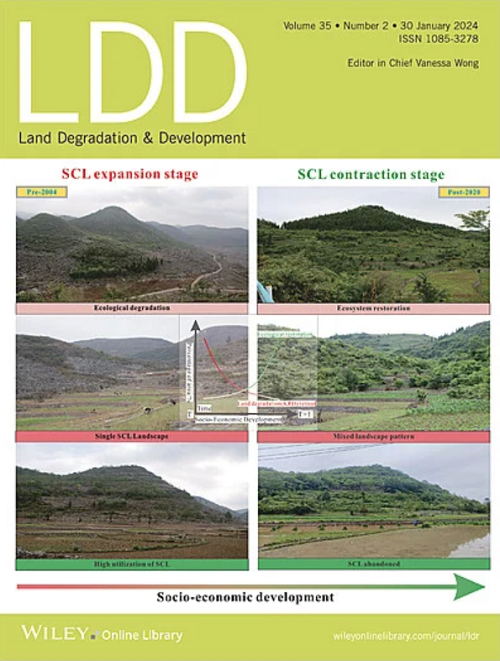大坝淹没调节植物多样性对三峡库区沿岸土壤多功能性的影响
IF 3.6
2区 农林科学
Q2 ENVIRONMENTAL SCIENCES
引用次数: 0
摘要
了解生物多样性与生态系统多功能性之间的关系对于预测物种丧失对生态系统服务可持续提供的影响至关重要。理论和实证研究普遍表明,生物多样性与生态系统多功能性之间存在正相关关系。然而,土壤多功能性(SMF)与植物多样性之间的内在联系机制仍不清楚,尤其是在动态河岸生境中。在本研究中,我们调查了中国三峡大坝调节河岸带的植物群落、10 种土壤功能及其驱动因素。研究结果表明,分类学、系统发育和功能多样性在α和β尺度上对SMF有正负两种影响。值得注意的是,大多数多样性指标与SMF呈负相关,尤其是在低海拔地区和大坝附近地区。α和β多样性对SMF的贡献相同,而功能多样性比分类学或系统发育多样性更能解释SMF。此外,非生物变量解释了 24% 的 SMF 变异,大大超过了生物变量解释的 3%。大坝淹没对SMF既有直接影响,也有由土壤pH值、容重和功能分散性介导的间接影响,所有这些都是阐明SMF变化的关键变量。我们的研究结果表明,大坝淹没会调节植物多样性对SMF的影响,并强调了生物因素和功能多样性在调节这种影响中的作用。这项研究对生物多样性普遍对生态系统多功能性产生积极影响的普遍观点提出了质疑,并拓宽了我们对植物多样性与 SMF 之间的联系及其在大坝诱发的水文变化下的驱动因素的理解。本文章由计算机程序翻译,如有差异,请以英文原文为准。
Dam Inundation Modulates the Effect of Plant Diversity on Soil Multifunctionality in the Riparian Zone of the Three Gorges Reservoir
Understanding the biodiversity–ecosystem multifunctionality relationship is critical for predicting the consequences of species loss on the sustainable provision of ecosystem services. Both theoretical and empirical studies generally demonstrate a positive biodiversity–ecosystem multifunctionality relationship. However, the underlying mechanisms linking soil multifunctionality (SMF) to plant diversity remain unclear, particularly in dynamic riparian habitats. In this study, we investigated the plant community, 10 soil functions, and their drivers within the riparian zone regulated by the Three Gorges Dam in China. Our results showed that taxonomic, phylogenetic, and functional diversity affect SMF at alpha and beta scales in both positive and negative ways. Notably, most diversity metrics are negatively correlated with SMF, especially at lower elevations and in areas near the dam. Alpha and beta diversity contribute equally to SMF, whereas functional diversity explains SMF better than taxonomic or phylogenetic diversity. Furthermore, abiotic variables explain 24% of the variance in SMF, significantly exceeding the 3% explained by biotic variables. Dam inundation has both direct effects on SMF and indirect effects mediated by soil pH, bulk density, and functional dispersion, all of which are critical variables in elucidating SMF changes. Our findings indicate that dam inundation modulates the effect of plant diversity on SMF and underscore the roles of biotic factors and functional diversity in mediating this effect. This study challenges the prevalent notion that biodiversity universally positively affects ecosystem multifunctionality and broadens our understanding of the linkages between plant diversity and SMF, as well as its drivers under dam-induced hydrological changes.
求助全文
通过发布文献求助,成功后即可免费获取论文全文。
去求助
来源期刊

Land Degradation & Development
农林科学-环境科学
CiteScore
7.70
自引率
8.50%
发文量
379
审稿时长
5.5 months
期刊介绍:
Land Degradation & Development is an international journal which seeks to promote rational study of the recognition, monitoring, control and rehabilitation of degradation in terrestrial environments. The journal focuses on:
- what land degradation is;
- what causes land degradation;
- the impacts of land degradation
- the scale of land degradation;
- the history, current status or future trends of land degradation;
- avoidance, mitigation and control of land degradation;
- remedial actions to rehabilitate or restore degraded land;
- sustainable land management.
 求助内容:
求助内容: 应助结果提醒方式:
应助结果提醒方式:


